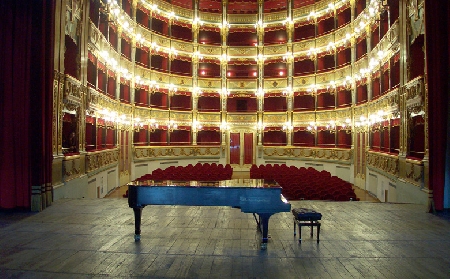
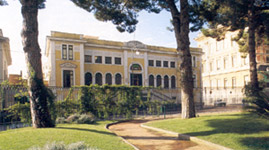
First route
1 Ancient magistrate’s court (Copeta palace), Via T. De Ruggiero
2 Tasso National Boarding School, Via T. De Ruggiero
3 Conforti Palace, Via Tasso
4 Fruscione Palace, Largo S. Pietro a Corte
5 Annunziatella Church, Via Canali
6 d’Avossa Palace, Via Botteghelle
7 Saint Anthony Abbot and Saint Rita's Church, Largo S. Pietro a Corte
8 Saint Matteo Piccolo Church, Largo S. Pietro a Corte
9 Saint Crispino and Saint Crispiniano's Church, Via Canali
10 Pedace Palace, Via Porta Catena
11 Saint Trofimena Church, Vicolo S. Trofimena
12 Verdi Theatre, Piazza Luciani
13 Saint Anne by the port Church, Via Santa Teresa
14 Serviceman's house, Lungomare Trieste


Born in the 8th century from the benedictin experience in the care of the wounded and the sick, the Salerno School of Medicine, reorganized by Frederick II in 1231, was the European model for medicine. When visiting Salerno we suggest a route starting from the Ancient Magistrate's Court (Palazzo Copeta), which was the seat of the school until 1811, and crossing an area rich in examples of 17th century architecture as the National Boarding School “Tasso”, the former convent of Saint Mary Magdalene which was the seat of the School of Medicine and of the School of Law of Salerno from 1811 to 1861, and Conforti, Fruscione and D’Avossa Palaces. The churches of Annunziatella, Saint Anthony Abbot, Saint Rita, "Little" Saint Matthew, Saint Crispin and Saint Crispinian are among the oldest in the city and keep precious works of Baroque art. Passing Palazzo Pedace and the church of Saint Trofimena (9th century), the visitor gets to the Verdi Theatre (opera house) and to the church of Saint Anna by the Port, which dates back to the 13th century and constitutes an ancient example of convents in Salerno. The route ends at the beautiful promenade of Salerno, where is the Serviceman's House, seat of the “F. Menna” foundation, a centre of studies for contemporary art and a splendid example of “essentialistic” architecture.
Second Route
1 Saint Maximus Palace, Via San Massimo
2 Saint Maria della Porta Church, Largo S.Tommaso d’Aquino
3 All Souls' Church (Monte dei Morti), Largo Plebiscito
4 Diocesan Museum, Largo Plebiscito
5 Saint Matthew Cathedral, Piazza Alfano I
6 Saint Catherine Chapel, Piazza Alfano I
7 Saint Thomas’ Hall, Piazza Alfano I
8 Archiepiscopal Curia, Via Duomo
9 Ceramic Museum, Larghetto Cassavecchia
10 Saint George Church, Via Duomo
11 Saint Augustine Church, Piazza S.Agostino
.jpg)
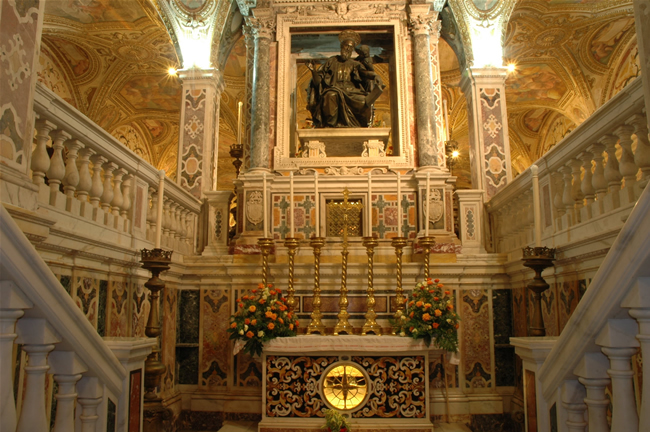
With a great renewal of culture the Salerno School of Medicine marks the change from empiricism to the birth of modern science. During your tour of the city we suggest a route inspired by the School, starting from the chapel of Saint Catherine and Saint Thomas’ Hall, prestigious seats of the school of medicine during the 11th century in Saint Mathew’s Cathedral where you can admire the interior and numerous works of art, the nearby Archiepiscopal Curia with its hall named "Temple of Pomona" and the colonnade from the “Capitolium” of Paestum and, in Via Monterisi, the diocesan museum with its Roman and medieval examples in the atrium and on the upper floors four rooms with works of art from the 16th to 18th centuries, such as miniated manuscripts, paintings, sculptures and the very rare “ Exultet” of the 13th century. You can also visit the nearby churches of All Souls' (Monte dei Morti) and Santa Maria della porta and the Ceramic Museum (with exhibits from the 18th to the 20th century). This routes leads also to the erstwhile convents and churches of Saint George (10th century) and of Saint Agustin (14th century) ending up at the Saint Maximus Palace (18th century) standing in the area of the palace built in 861 AD by order of Guaferio, prince of Salerno.
Third Route
1 Church of S. Peter by the Court, Largo San Pietro a Corte
2 Salerno School of Medicine Museum, Via dei Mercanti
3 Forge, Via dei Mecanti
4 Domus Romana, Via dei Mercanti
5 Church of Our Saviour "de Fundaco", Via dei Mercanti
6 Via dei Mercanti, Via dei Mercanti
7 Sedile di Portanova, Piazza Portanuova

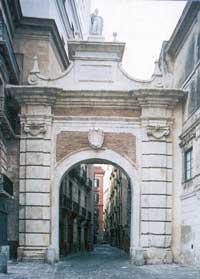
The oldest University in Europe and in the whole world is the Salerno School of Medicine, founded around the 7th century AD and closed in the 19th century AD. A beacon of civilization and a model of scientific application and therapeutic practice, the School had many different seats over the centuries. The first seat was probably in the church of Saint Peter by the Court - built as Palatine chapel around 787 AD by order of the longobard prince Arechi II - where are frescos dating back to the 12th and 15th centuries AD. During the visit you'll be able to admire the works kept in S. Antonio’s and S. Rita’s (frescos from the 18th to the 20th centuries AD).You can also stroll Via Dei Mercanti, the most typical street of the ancient Salerno, narrow and typically medieval, but busy with people and shops, and visit the church of Our Saviour "De Fundaco" (15th century AD) and the Domus Romana, an important relic of Roman Salerno which stands beside the medieval Forge and former convent of Portanova and is preceded by the Salerno School of Medicine Museum. The Domus dates back to the 4th century AD and contains quite a few traces of frescos; the Forge was in use until the 12th century AD; the former convent covers constructions from the 11th century AD.
Fourth Route
1 Arechi Castle, Via Benedetto Croce
2 "Umberto I" School, Via S. De Renzi
3 Church of Saint Anne in Saint Lawrence, Via S. De Renzi
4 Convent of S. Maria della Consolazione
5 Largo Scuola Medica, Largo Scuola Medica
6 Church of S. Maria delle Grazie, Largo Luciani
7 Garden of Minerva, Via Porta Di Ronca
8 Ruggi d'Aragona Palace, Via Tasso
9 Church of S. Maria de Lama, Gradoni Della Lama
10 Church of S. Andrea de Lama, Via Porta Rateprandi
11 Largo Campo, Largo Sedile Del Campo
12 Medieval Forge, Via Fasanella
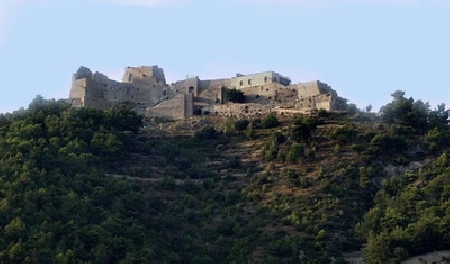
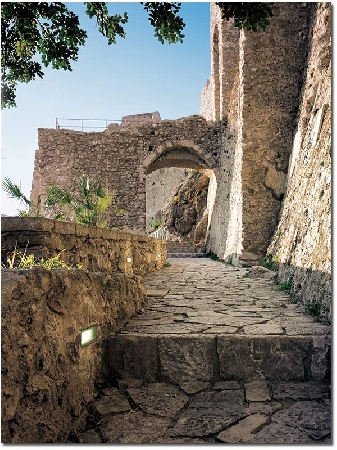
The diffusion of medicine in Europe is due to the Salerno School of Medicine, founded around the 8th century AD by four legendary teachers: Elenius, Pontus, Adela and Salerno. The visit of Salerno may include routes inspired by the famous “schola”. One of these routes winds around the area with the greatest medieval remains, starting from Arechi Castle and continuing to the Umberto I School (which in the 11th century AD was the convent of Saint Nicholas) founded in 1060, the church of Saint Anne in Saint Lawrence at its side - an ancient edifice rebuilt in the 17th century AD - where the visitor can admire the paintings of Angelo Solimena and Francesco De Maria. We suggest to continue for the ex women’s prison which used to be the convent of Santa Maria Della Consolazione, founded in 1559 AD, passing through largo Scuola Medica Salernitana. This route enables leads also to the church of S. Maria delle Grazie, with wonderful interiors, to the Garden of Minerva where Matteo Silvatico, an illustrious exponent of the Medical School, lived in the 13th century AD and cultivated the herbs used to make the medicines, to Ruggi d’Aragona palace ( XVI century), the churches of S.Maria de Lama (XII century) and S.Andrea de Lama (XII century), both with exceptional frescoes dating back to the VIII century, and ends in Largo Campo and at the medieval forge (X century).